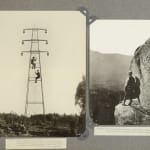U.S. Forest Service
Scenes of U.S. Forestry, 1900s-20s
Photo album; Silver prints (88)
3 1/2 x 4 1/2 to 8 x 10 inches
Each with inventory numbers in the negative and corresponding printed caption labels affixed on page recto.
Each with inventory numbers in the negative and corresponding printed caption labels affixed on page recto.
Sold
Further images
-
(View a larger image of thumbnail 1
)

-
(View a larger image of thumbnail 2
)

-
(View a larger image of thumbnail 3
)

-
(View a larger image of thumbnail 4
)

-
(View a larger image of thumbnail 5
)

-
(View a larger image of thumbnail 6
)

-
(View a larger image of thumbnail 7
)

-
(View a larger image of thumbnail 8
)

Early 20th century photo album containing a breathtaking survey of US National Forests in the first decade of its inception. With compelling scenes of logging, ranching, experimental stations, sweeping vistas...
Early 20th century photo album containing a breathtaking survey of US National Forests in the first decade of its inception. With compelling scenes of logging, ranching, experimental stations, sweeping vistas and dramatic fires. Primarily documenting western locations, the forests represented in the collection include the following: Wallowa, Rio Blanco, Angeles, Stanislaus, Battlemont, Arapaho, Coconino, Cheyenne, Wasatch, and others.
Shortly after the creation of the Division of Forestry in 1898, field agents were required to submit photographs along with their written inspection reports, at the behest of the division’s leader Gifford Pinchot. A photographer himself, Pinchot recognized the medium’s importance not only as a means to document America’s forests, but as a tool to sway the general public toward the necessity of their preservation.
In these first few years, photographs were sourced a few different ways. If a field agent did not know how to work a camera or where to point it, as many did not, the work would be outsourced to photographers from local studios, or existing prints would be purchased. There are a few examples of these in the present collection, such as a dramatic photo of a group of loggers atop a pile of felled Douglas firs in Mason County, Washington, which was taken by the Olympia-based photographer B.C Collier, a contemporary of Darius Kinsey. Similar images of commercial logging efforts, including one with a caption describing the action as “wasteful felling,” were likely included in order to provide visual evidence of the industry’s unregulated practices.
In 1906, after Pinchot became the first head of the newly designated Forest Service, he tasked botanist Geroge Sudworth with crafting photographic guidelines for the field agents nationwide. Sudworth, who had previously photographed California’s giant sequoias, disseminated a set of standardized instructions and principles on camera use and composition. The views of Wallowa were photographed by forest J.T Jardine, head of the experimental station there, and the Arizona and Colorado was done by A.G Varela, an agent from the Washington office.
There are a handful of photographs by Thomas Lukens, including a thoughtfully-composed scene of a ruckenfigur gazing out over San Bernardino National Forest. Lukens, known as the “father of forestry,” is best remembered as a California conservationist alongside John Muir, but his photographic work, created when he was a Forest Service supervisor, demonstrates a sophisticated, keen eye that he shared with many of his colleagues.
Many members of the Service considered themselves foresters first and foremost but, as this striking collection exemplifies, their remarkable photographic efforts, which captured the imposing grandeur of the National Forests, should earn recognition as important American photographers.
Shortly after the creation of the Division of Forestry in 1898, field agents were required to submit photographs along with their written inspection reports, at the behest of the division’s leader Gifford Pinchot. A photographer himself, Pinchot recognized the medium’s importance not only as a means to document America’s forests, but as a tool to sway the general public toward the necessity of their preservation.
In these first few years, photographs were sourced a few different ways. If a field agent did not know how to work a camera or where to point it, as many did not, the work would be outsourced to photographers from local studios, or existing prints would be purchased. There are a few examples of these in the present collection, such as a dramatic photo of a group of loggers atop a pile of felled Douglas firs in Mason County, Washington, which was taken by the Olympia-based photographer B.C Collier, a contemporary of Darius Kinsey. Similar images of commercial logging efforts, including one with a caption describing the action as “wasteful felling,” were likely included in order to provide visual evidence of the industry’s unregulated practices.
In 1906, after Pinchot became the first head of the newly designated Forest Service, he tasked botanist Geroge Sudworth with crafting photographic guidelines for the field agents nationwide. Sudworth, who had previously photographed California’s giant sequoias, disseminated a set of standardized instructions and principles on camera use and composition. The views of Wallowa were photographed by forest J.T Jardine, head of the experimental station there, and the Arizona and Colorado was done by A.G Varela, an agent from the Washington office.
There are a handful of photographs by Thomas Lukens, including a thoughtfully-composed scene of a ruckenfigur gazing out over San Bernardino National Forest. Lukens, known as the “father of forestry,” is best remembered as a California conservationist alongside John Muir, but his photographic work, created when he was a Forest Service supervisor, demonstrates a sophisticated, keen eye that he shared with many of his colleagues.
Many members of the Service considered themselves foresters first and foremost but, as this striking collection exemplifies, their remarkable photographic efforts, which captured the imposing grandeur of the National Forests, should earn recognition as important American photographers.







